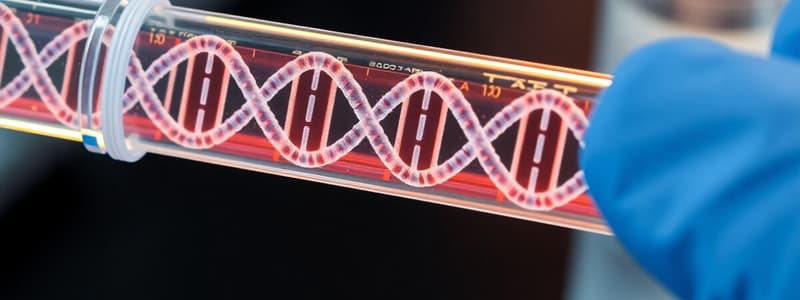Podcast
Questions and Answers
What is the significance of 'sticky ends' in DNA cloning?
What is the significance of 'sticky ends' in DNA cloning?
- They enhance the process of DNA degradation.
- They facilitate the joining of DNA fragments from different organisms. (correct)
- They prevent the replication of DNA.
- They allow for easy separation of DNA molecules.
How many copies of DNA can be produced after 25 cycles of the amplification process?
How many copies of DNA can be produced after 25 cycles of the amplification process?
- 1 million copies (correct)
- 100 million copies
- 100 billion copies
- 1,000 copies
What is a primary advantage of using the polymerase chain reaction (PCR) in forensic analysis?
What is a primary advantage of using the polymerase chain reaction (PCR) in forensic analysis?
- It requires living cells for DNA analysis.
- It can amplify DNA from minute samples quickly. (correct)
- It is slower than traditional cloning methods.
- It relies on complex culturing techniques.
What role does DNA ligase play in DNA cloning?
What role does DNA ligase play in DNA cloning?
Which of the following statements about restriction endonucleases is true?
Which of the following statements about restriction endonucleases is true?
What type of DNA can be amplified using the polymerase chain reaction?
What type of DNA can be amplified using the polymerase chain reaction?
What occurs when two DNA fragments with complementary bases meet at their sticky ends?
What occurs when two DNA fragments with complementary bases meet at their sticky ends?
What is the primary purpose of primers in the polymerase chain reaction (PCR)?
What is the primary purpose of primers in the polymerase chain reaction (PCR)?
At what temperature does the separation of the DNA double helix occur during PCR?
At what temperature does the separation of the DNA double helix occur during PCR?
What is the significance of Taq polymerase in PCR?
What is the significance of Taq polymerase in PCR?
What occurs during the annealing stage of PCR?
What occurs during the annealing stage of PCR?
During which stage of PCR is DNA synthesized?
During which stage of PCR is DNA synthesized?
What are dNTPs in the context of PCR?
What are dNTPs in the context of PCR?
What role does the thermocycler play in PCR?
What role does the thermocycler play in PCR?
How many copies of the original DNA fragment are produced after one complete cycle of PCR?
How many copies of the original DNA fragment are produced after one complete cycle of PCR?
Flashcards are hidden until you start studying
Study Notes
Polymerase Chain Reaction (PCR)
- PCR is a highly automated and efficient process.
- PCR requires:
- DNA fragment to be copied: The target DNA sequence for amplification.
- Taq polymerase: A heat-stable DNA polymerase isolated from the bacterium Thermus aquaticus that can withstand the high temperatures required for PCR.
- Primers: Short sequences of nucleotides complementary to the ends of the DNA fragment, providing starting points for DNA synthesis.
- Nucleotides (dNTPs): Building blocks of DNA, containing the four bases (adenine, guanine, cytosine, thymine).
- Thermocycler: A machine that precisely controls temperature changes during the PCR process.
PCR Steps
- Separation (Denaturation): The reaction mixture is heated to 95°C, separating the DNA double helix into single strands by breaking the hydrogen bonds between the base pairs.
- Annealing: The temperature is lowered to 55°C, allowing primers to bind to their complementary sequences on the DNA strands.
- Synthesis (Extension): The temperature is raised to 72°C, the optimal temperature for Taq polymerase to add complementary nucleotides to the primer-bound DNA strands, extending the DNA sequence.
- This cycle is repeated multiple times, amplifying the DNA exponentially.
Importance of PCR
- PCR revolutionized science and medicine by allowing for the rapid and efficient amplification of even minute amounts of DNA.
- It has numerous applications, including:
- Forensic science: Amplifying DNA from crime scenes for analysis and identification.
- Diagnostic testing: Detecting pathogens or genetic mutations in clinical samples.
- Research: Studying gene expression, mutation analysis, and gene cloning.
Advantages of PCR
- Speed: PCR can produce billions of copies of DNA in a few hours.
- Specificity: Primers ensure selective amplification of the desired DNA sequence.
- Sensitivity: Primers can amplify extremely small amounts of DNA.
- Versatility: PCR can be used with a wide variety of DNA samples.
Sticky Ends
- Restriction endonucleases: Enzymes that cut DNA at specific recognition sequences.
- Recognition sites: Sequences of DNA that are cut by restriction endonucleases.
- Staggered cuts: Restriction endonucleases can cut DNA in a staggered manner, leaving "sticky ends" with single-stranded overhangs.
- Complementary sticky ends: Fragments cut by the same restriction endonuclease have complementary sticky ends, allowing them to anneal (join) together via hydrogen bonding.
- DNA ligase: An enzyme that seals the gaps in the DNA backbone, joining the fragments together.
Importance of Sticky Ends
- Gene cloning: Sticky ends allow for the insertion of DNA fragments from one organism into the DNA of another, enabling gene cloning.
- Recombinant DNA technology: Sticky ends are crucial for creating recombinant DNA molecules, which are used in biotechnology and medicine.
Studying That Suits You
Use AI to generate personalized quizzes and flashcards to suit your learning preferences.




